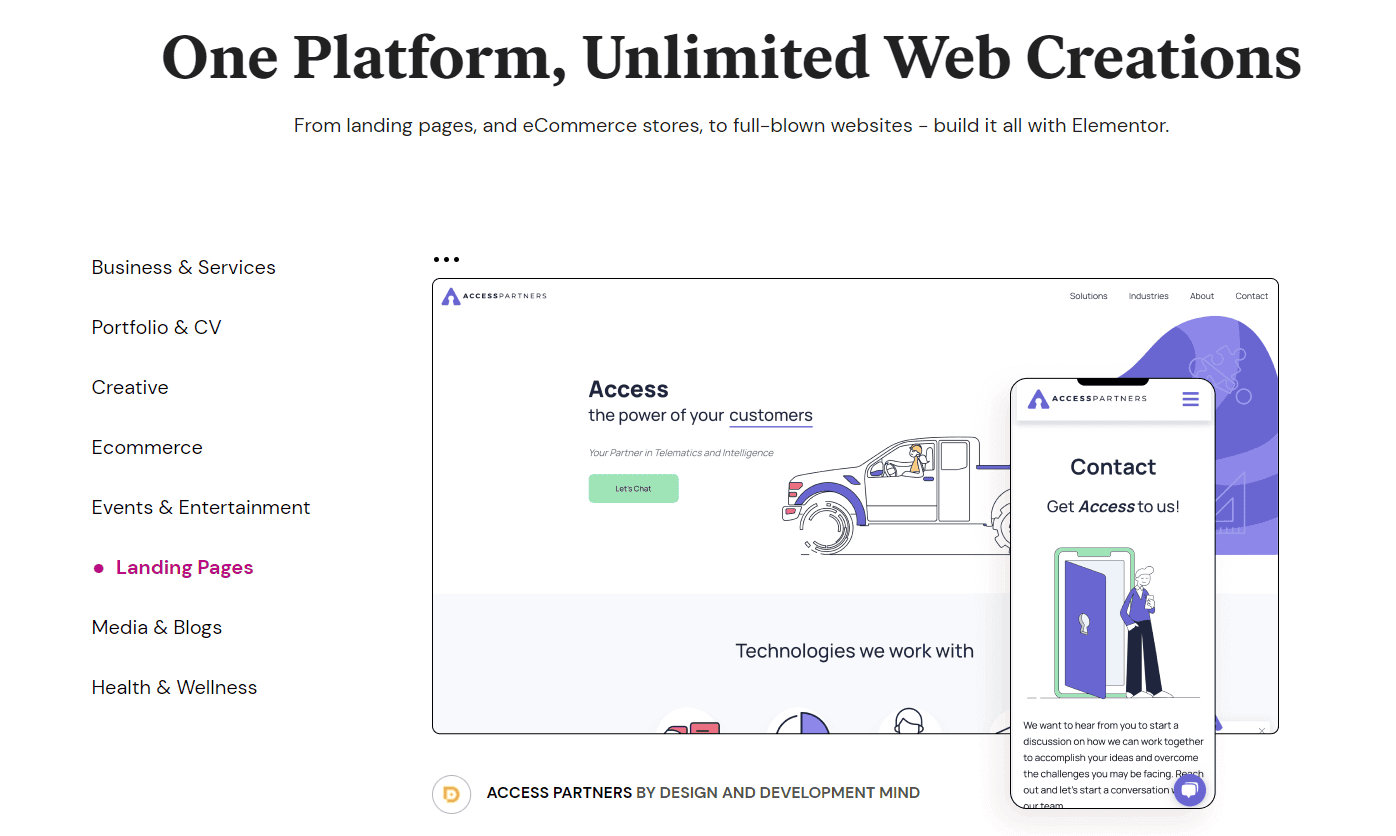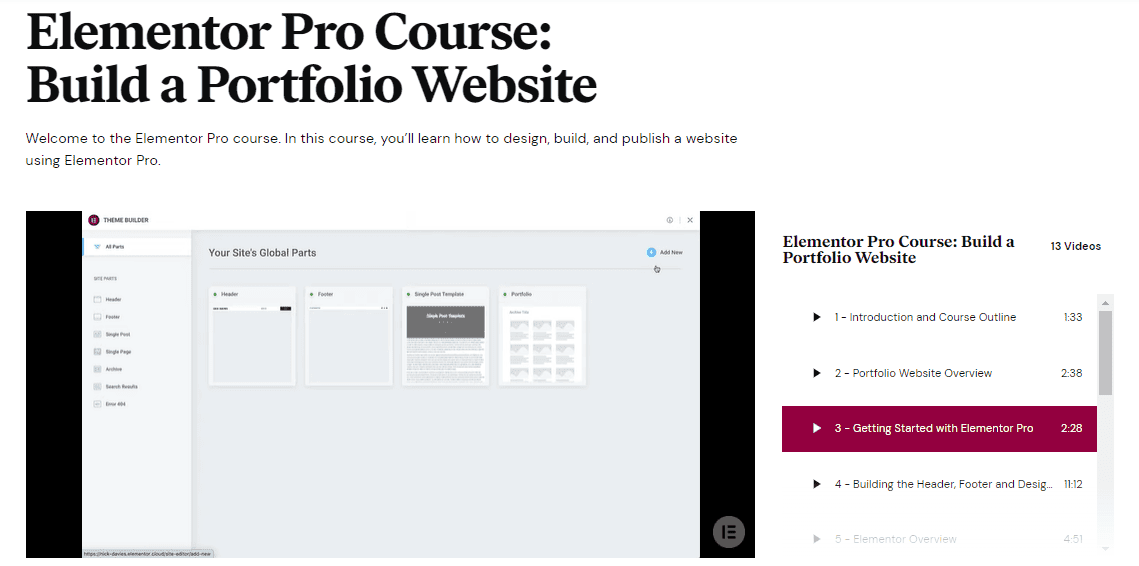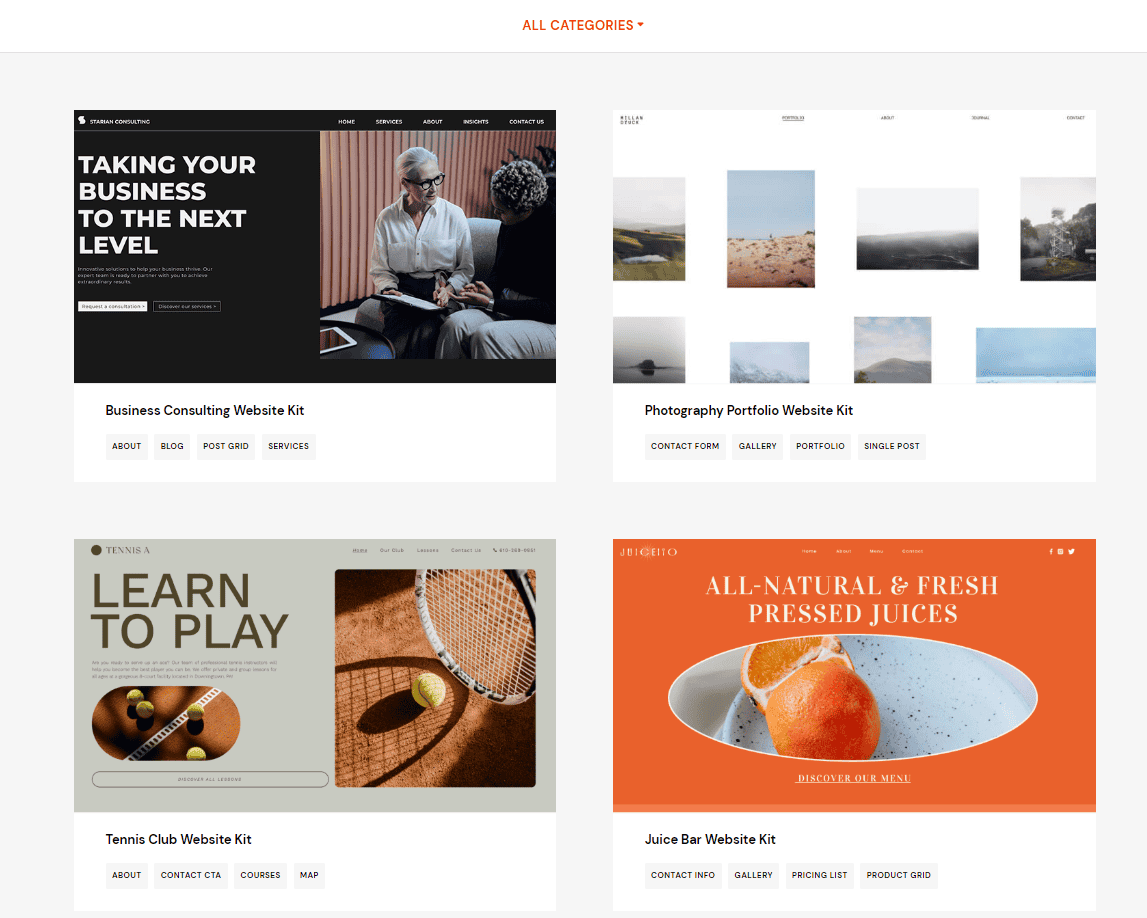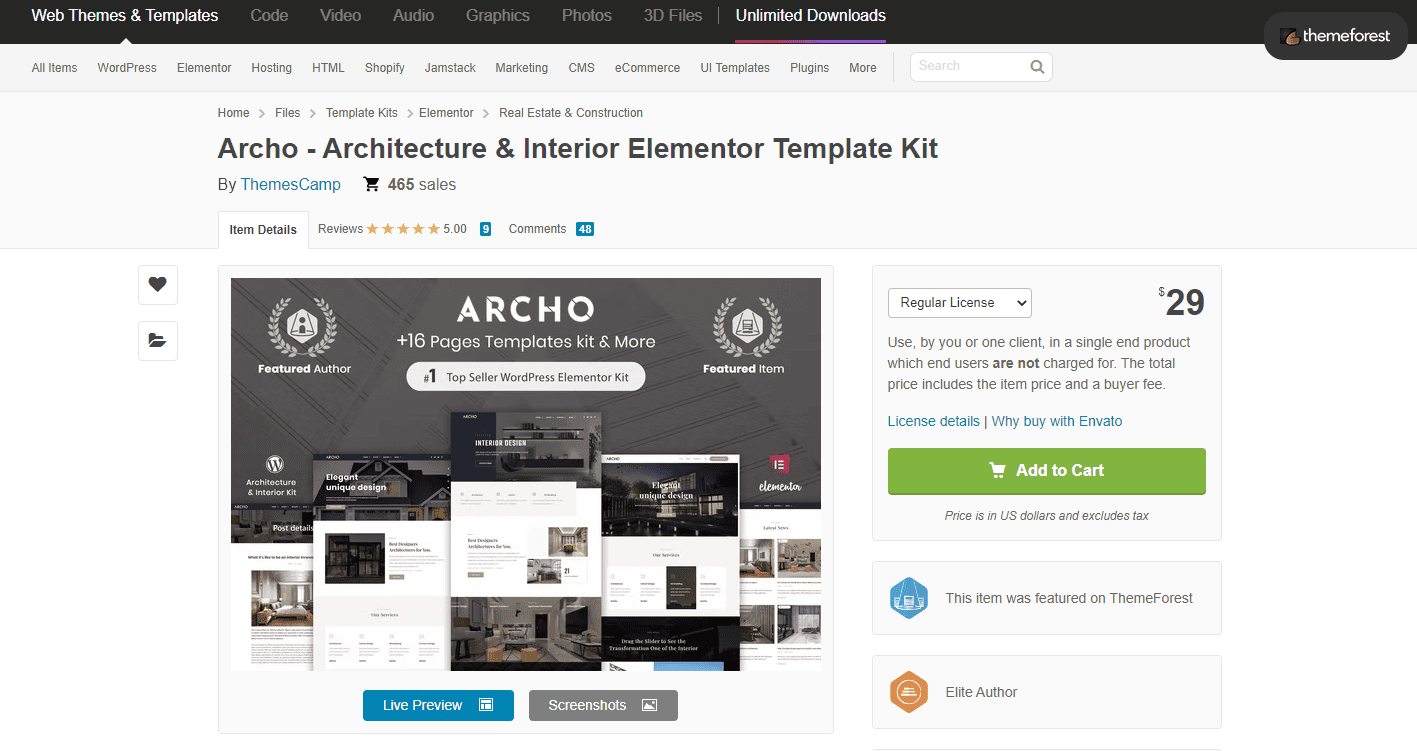|
|
How much do you know about Elementor Templates? These new-generation static themes are easy to build and offer developers and digital creatives an opportunity to cash in on the no-code revolution. Get insider tips from four WordPress professionals on how to successfully sell Elementor Templates (and Template Kits) in 2023.
When I joined Freemius in January, I assumed that WordPress was the way I left it after cutting my teeth at a marketing agency in 2018. Back then, building websites — even from themes — was the domain of devs, not writers. As far as I was concerned, Java[Script] was both an island and a word that pretentious people used to refer to coffee.
Questionable ‘jokes’ aside — over the past nine months, I’ve been learning about block editors and full site editing (FSE) as well as observing how these no-code builders are taking the WordPress Universe by cosmic storm. Interested by what the rise of ‘no-code’ means for software stalwarts, I explored the current sentiment that WordPress themes are slowly dying with Freemius CEO Vova Feldman. Vova points out that while block editors are undeniably making major waves in our space, it’s too early to speculate about when/whether themes will become obsolete.

Instead, it would be wiser to focus one’s energy on the possibilities offered by plugins like Elementor — a block editor-based web-creation solution that’s been around for two years longer than Gutenberg has. Since 2016, Elementor has been creating opportunities for digital creators — including those with little to no coding experience — to influence the future of web design and make money while doing so.
For this article, I reached out to four WordPress entrepreneurs to help devs and non-devs alike learn how to sell Elementor Templates in 2023:
- Matt Medeiros from The Matt Report
- Jacob Stimpson from Starfish Reviews
- Mohamed Moussa from ThemesCamp
- Amit Keren from Unlimited Elements
But first, some background.
What Is Elementor and What Are Templates?
Elementor was founded by Yoni Luksenberg and Ariel Klikstein to make web creation easier for professionals like them. Long story short, Elementor currently powers 7% of the internet and has more than 10 million active installs (yep, you read that right).

So, what exactly does Elementor do? Or, more specifically — what is it?
In a nutshell, Elementor is a no-code drag-and-drop front-end page builder and editor that helps you create websites with the aid of Templates.
According to Elementor, Templates let you convert a design into a static document. Essentially, a Template can either be an entire web page or a single element — like a header or footer — that can be used on countless web pages.
Getting started with Elementor is simple:
- Add the free Elementor plugin to your WordPress website and activate it
- Add a new page on WordPress and click the ‘Edit With Elementor’ button
- Start building web pages using Elementor’s Templates
Why Are Page Builders Like Elementor Groundbreaking for Designers and Non-Dev Web Creators?
Traditionally, WordPress theme developers are required to know HTML, CSS, and programming languages like JavaScript and PHP to build websites. They also need to understand how web pages are rendered in different places. This is dictated by the WordPress.org Theme Handbook on the official WordPress repository that explains how to build themes from the ground up.
When a WordPress developer creates a theme, they have to build different templates for each page. Moreover, every template requires that different filters be added manually to define the varying functionalities of each page: one filter for before and another for after adding content, a filter before the footer, et cetera.
In addition, developers need to use plugins to manipulate WordPress and make visual changes or trigger a different logic in a certain area of the theme.
If this makes you want to cry a little bit, it’s because programming websites is no walk in the park. There is a reason developers say that code is poetry: coding a website is one heck of a task.
No-code page builders like Elementor are replacing traditional themes because they offer all the aforementioned code infrastructure, and allow users to build Templates — which, as mentioned, can range from an entire web page to a footer — via the WYSIWYG drag-and-drop editor. Each Template can be exported, saved, and used across multiple pages on a website. The magic here is that you don’t need to have any advanced coding knowledge to do this — if you can use a page builder, you can create and sell Elementor Templates.
This wizardry is especially magical for designers, who can recreate beautiful designs (from, say, Photoshop or Figma) as Elementor Templates and sell them as part of their existing product catalogs. Making an Elementor Template requires (almost) no coding on the designer’s part. A Template is simply a configuration of settings that Elementor automatically digests and converts into something that looks great.
It’s a way to compress the data instead of storing the entire HTML, and Elementor saves the meta-data in a JSON formatted settings file(s). If a user wants to load the Template onto another website, Elementor knows how to take those settings, parse them, and render them nicely with any other website that uses Elementor.
Neat, eh?
How To Get Started and Sell Elementor Templates
For the sake of simplicity, let’s assume that you already have a blank WordPress website. This is the bare minimum required to install the Elementor plugin and create and sell Elementor Templates.
Now, let’s get into Template creation 101.
For absolute beginners, Elementor has a cool 13-part video tutorial course that shows you how to create a no-code website (or Template) from scratch with the Hello Theme in WordPress. Once you’ve covered this, you’ll have a solid foundation to build on. Elementor Academy has tons of handy video tutorials that cover, well, everything you’ll (probably) want and need to know — from creating a video playlist popup to adding a dynamic lightbox.

While you’ll be able to build, export, and sell Elementor Templates with the free version of Elementor, I suggest subscribing to Elementor Pro if you’re going to take a serious stab at monetizing them. The pro version lets you build header and footer Templates that can be stored in Template Kits, and it supports FSE too. Template Kits are a combination of multiple Templates that allow you to create a multi-page website, but more on that in a second. The pro version also gives you access to extra customization functionalities, seamless form integration, professional Templates and blocks, and key professional widgets and features.
You can find out more about the differences between the pro and free versions here. Now, on to Elementor Template Kits…
What Are Elementor Template Kits?
In essence, each Template within a Template Kit is a separate page — Homepage, About Us, Blog, Contact, etc. — or element (like a footer) that includes all standard components and functionalities.

This Elementor blog post (featuring a complementary video tutorial), breaks it down piece by piece and shows you how to build a Template Kit from scratch.
Once the Kit’s complete, you’ll need to save it.
Importing and Exporting Templates and Template Kits
Elementor has a step-by-step guide on saving, importing, and exporting single Templates from the Template Library.
This tutorial explains how to download Template Kits as a .ZIP file with the Export Kit function. As a bonus, any content created with additional plugins will be exported with a full Kit if selected. I also recommend watching this tutorial, which shows you how to import Template Kits.
Knowing how to import and export Elementor Templates and Template Kits is essential because:
- You’ll likely need to provide most of your customers with some support and guidance when they install a Template or Kit.
- Importing previews of your Templates and Kits to your online store is essential since customers will want to get a look at your products before committing with cash.
Simple enough, so:
Show Me How To Sell Elementor Templates and Template Kits
This is where the real beauty comes in.
First off, you are under no obligation to sell Elementor Templates on Elementor’s store. In fact, the only Templates and Template Kits they list are created in-house.
Custom-designed Templates and Kits can be sold on marketplaces, of which Envato’s ThemeForest and Envato Elements are the most well-known. From what I can see, Template Kits are the favored product offering on marketplaces. My guess as to why is that they are a more comprehensive solution and offer more functionality and variety to customers.
Envato lists some requirements for WordPress Template Kits, and — at the time of writing — only allows them to be built with Elementor. Envato also has a handy tutorial on how to create Template Kits. Should you choose to sell Elementor Template Kits there, you’ll need to download the Template Kit – Export plugin to export them before uploading them to the marketplace.
Other marketplaces that sell them include:
However, you’re by no means confined to marketplaces. There’s another — potentially more lucrative — avenue to sell Elementor Templates and Kits..
A Potential Goldmine for Your Online Store
Back on the subject of no-third-party-required: There is a massive opportunity to sell Elementor Templates and Template Kits on your own website.
The scale of the operation is up to you.
You could aspire to grow it into a full-time business or employ Templates as another product category in your existing inventory. Because of the relative ease with which Templates and Kits can be built on Elementor, there is the possibility to create one or even a few of them every day.

Because of their popularity, my pricing recommendations are based on the going rates for Template Kits on marketplaces.
Template Kits on ThemeForest are priced between $7 and $50, with the most common being $24 (some require the user to have Elementor Pro installed). Prices when selling Elementor Template Kits fall within the same price range outside of marketplaces. Moreover, many independent sellers offer ‘all access’ memberships for $100+ to their entire Template Kit library.
If you start out by selling even one Template Kit a day on your own online store at a once-off price of $24, it’s a clean and easy sale since you won’t need to provide mandatory post-sale support or hosting or pay commission fees to a marketplace.
This opportunity is not only limited to the digital creator market. WordPress plugin and theme developers also stand to capitalize, since they can draw on their experience to build and sell Elementor Templates and Kits that tick all the boxes a good website should.
If you’re worried that they might be too difficult to market or that the marketplace monopoly could dwarf your efforts, fear not. Freemius has your back, and we can provide you with an eCommerce sales solution to help you succeed. How to get started with Freemius.
Deciding to sell Elementor Templates and Kits is a legitimate prospect that looks great on paper. However, while the Elementor market has certainly surpassed niche status, there is little wisdom or guidance on how to sell them as a full-fledged venture. To get the inside scoop, I reached out to four WordPressers who’ve had success with Elementor products.
Matt Medeiros’s Tips to Help You Sell Elementor Templates and Template Kits
Matt was recently featured in our 56 WordPress Experts to Follow Online article. He has vast business experience in the WordPress ecosystem and is arguably best known for presenting The Matt Report, a podcast and blog about digital entrepreneurs and the products and services they use to build their businesses online. He is also Director of Podcasting Success at Castos, where he coaches clients on creating and managing successful podcasts for their brands.
Castos’s Seriously Simple Podcasting plugin offers a Template Kit as a free bonus for users that are subscribed to Elementor or Elementor Pro. According to Matt, this has been a big marketing draw for them.
How Have Elementor Template Kits Benefitted Castos’s Product Offering?
Castos’s customers are podcasters and not developers, so including a Template Kit with each sale bypasses a potential technical hurdle. Specifically, when customers are recording podcasts and trying to promote their content, figuring out how to build a website from scratch is probably the last thing they have the time or energy for.
Elementor offers a great, easy way to build a website. By including a Template Kit as a free add-on, we are providing our customers with awesome extra value in turn. And if they have Elementor Pro installed, there’s also the opportunity to work with stuff like dynamic content.
Customers don’t need to figure out how to query WordPress websites or display all of their podcasts as custom post types, since this is already included in the Template Kit — all they need to do is enable the functionalities they’d like to use.
How to Start a Business and Sell Elementor Templates and Kits as a Developer
“If I were considering to sell Elementor Templates and Kits, I’d start by assessing my skills and figuring out which market I’d like to serve. What Castos is trying to do is to fast-track the process of getting our customers’ podcasting shows off the ground. Therefore, our Template Kits include elements that are specific to the podcasting game: a podcast landing page, subscribe page, email capture, query for all the podcast posts — stuff like that.”
However, a customer who is looking for a more branded or customizable website probably won’t be interested in Castos’s offering, since they’ll likely require it to be built from scratch. Adding to this point, Matt emphasizes that designers looking to sell Elementor Templates and Template Kits would do well to create a range of designs for different industries.
Don’t try to be everything to everyone. Figure out who the customer for each Template Kit is, and try to find a great solution for their needs.
What Makes an Elementor Template or Template Kit Great?
It’s worth noting that Elementor is constantly updating itself, which means that the code behind Templates changes too. In this regard — especially if you’re going to take a serious stab at selling Elementor Templates and Template Kits — it wouldn’t hurt to learn some basic coding.
“We continuously improve the code around our Template Kits so that a customer won’t break a website if they are going to upload one of the Templates,” Matt says.
Adding to this point, aspiring to sell Elementor Templates and Kits demands that you stay abreast of developments in Elementor via tutorials and other supporting content.
Has Castos Experienced Any Support Issues With Elementor Template Kits?
Technical support doesn’t seem to be an issue once you sell Elementor Templates and Kits to customers, since there is a very slim chance of anything breaking. Elementor products work with HTML — a relatively straightforward code — which means that there likely won’t be a train smash if Elementor decides to make major changes to a product version. If you know some basic HTML, you could probably fix it yourself.
The only real support issue is giving guidance to customers who are trying to load a Template or Kit, make some design changes, or find elements like the contact form.
Matt jokes that for Castos, free Template Kits open up the same can of worms that free themes do. “It’s like, ‘Hey, thanks for making this free thing. Now design a website for me.’”
Can You Sell Elementor Templates and Template Kits Full-Time?
My own two cents — no, I wouldn’t want to build a business by trying to sell Elementor Templates and Kits exclusively. The only way you’re going to be able to compete is through sheer volume — by creating a different solution for every single category.
Instead, Matt recommends finding a lucrative market — like higher education or finance — and including niche-specific designs to sell Elementor Templates and Kits as part of your product offering. In time, you might end up creating a massive inventory, which could then become a business venture in itself.
Are There Any Risks Involved in Selling Elementor Templates and Kits?
According to Matt, the biggest risk is probably going to be competition — which has always been the case in WordPress — if you want to sell Elementor Templates and Template Kits successfully.
Try and figure out what your competitors are doing really well. It might be customer service or great messaging. Don’t let the competition hold you back, but make sure that you assess it before getting into the game.
As it turns out, Castos is not the only WordPress company that includes a free Elementor Template Kit with their plugin. And — as the next entrepreneur I spoke to illuminated — this little nugget of knowledge presents its own lucrative opportunity.
Jacob Stimpson’s Pointers on Pitching Template Kits to Your Target Market
Jacob is co-owner of Starfish Reviews, a plugin that offers a funnel for capturing customer reviews and sorting them into collections. Similar to Castos, Starfish Reviews offers free Template Kits as a tool to accelerate the implementation of their plugin. Essentially, a user could opt to use the entire Template Kit, or import a single Template from the Kit to their website and use the Starfish Reviews plugin on that page.
Jacob believes that in the current market, Elementor Templates and Template Kits are complementary add-ons to existing products to increase value for customers.
How to Sell Elementor Templates and Template Kits as an Easy Solution for New Businesses
When someone is starting a new business, they often don’t have the capital to pay a developer to code a flashy website from scratch. Thing is, they need neither in the first place.
Think about it. If you’re a chiropractor or a pizzeria owner, what more do you require than a homepage, a dedicated landing sales page, a list of your products and/or services, a gallery, [potentially] a blog, a contact page, and reviews to solidify social proof?
A strategic way to sell Elementor Templates and Template Kits would be to offer SMBs (small and medium-sized businesses) a fast and effective solution that bypasses the expense of commissioning a traditional website.
Jacob says that once Starfish Reviews’ customers have received their Template Kit, the rest of the process takes care of itself. “All they need to do is import the JSON template file from Elementor to their blank WordPress website, make a few copy changes, potentially add a few images, and install our plugin. It allows them to execute the growth of their company much faster.”
Jacob’s Advice to Successfully Sell Elementor Templates and Kits
Learning to sell Elementor Templates and Kits will require some industry research. An effective route is to join the following Elementor Facebook groups.:
- Global Elementor Community
- Elementor Pro Community
- Elementor Page Builder Users
- Elementor Design Community
Learn as much as you can from others, and try to become the expert in your market niche. However, this strategy should always be treated as a launching pad for your endeavor, seeing as there will likely be thousands of other creators who have the same plan as you.
If you want to make more money selling Elementor Template Kits, you have to create your own demand. First, identify why a customer in the market you’re targeting would want or need a new website and establish what that website would require to meet their needs. Then, you need to convince them that buying one of your Elementor Template Kits is going to save them time and money.
If Starfish Reviews were to sell Elementor Templates and Template Kits as a separate offering, we might have a few customers who would buy them. But the way that we create a demand for them is by including them as a complementary offering with our product that helps our customers gain even more value.
Essentially, the main purpose that free Template Kits serve for Starfish Reviews is to help them to sell more plugin licenses. However, Jacob believes there could be a way to sell Elementor Templates and Template Kits as a full-time gig…
Pitch to Dudes Like Him!
Business owners often require sales or product landing pages for their websites, but they might not even be aware of it. And even if they are, many are reluctant to take action because of the concern that it could be costly to ask a developer to code landing pages from scratch or to design a new website.
“As an Elementor Template Kit creator, you could reach out to businesses with a PDF preview of what an additional sales landing page (with their images and branding included) could look like, and explain that an Elementor Template can simply be imported as an add-on to an existing website,” Jacob suggests.
Alternatively, if a business’s website is seriously outdated, you could pitch a ready-to-be-imported Template Kit and explain how this will save them tons of time and money when compared to coding a new website or installing a theme.
Jacob also mentions that you can reach out to plugin owners and pitch the idea of creating an Elementor Template Kit for them as an add-on to their product. “I actually paid someone to build our Template Kit, because I didn’t have the time to do it. And if I’m willing to pay for it, lots of other people must be too.”
At this point, you’re probably wondering whether anyone has managed to sell Elementor Templates and Kits and make a full-time gig out of it. Please allow me to show you…
How Mohamed Moussa Created the Best-Selling and Top-Rated Template Kit on ThemeForest

Mohamed is the Founder and CEO of ThemesCamp, a US-based WordPress theme shop and Template Kit design agency. Mohamed holds a master’s degree in engineering with a specialization in lighting design. This industry experience helped him spot a niche for customizable websites tailored to the needs of architects and interior designers.
Out of everyone I interviewed, Mohamed has the most industry-specific experience and expertise when it comes to selling Elementor Template Kits.
When and Why Did ThemesCamp Branch Into Template Kits?
In May 2020, the team saw that there was an opportunity to sell Elementor Templates and Template Kits as a pre-built solution for some of their clients’ websites. Gutenberg had only become the ‘default’ block editor for WordPress by August of that year, while Elementor was already leaps and bounds ahead in both functionality and accessibility.
What Made Archo So Successful?
Cliché as it may be, ThemesCamp was lucky to be in the right place at the right time, and Archo was practically an overnight success. Many clients bought the Template Kit based on its layout alone, and rave reviews for after-sales support and ease of installation soon followed.
“It wasn’t long before Archo was ThemeForest’s top-ranking and best-selling Template Kit,” Mohamed says. “Additionally, after a year, Envato selected it to be featured on their marketplace.”

Archo’s success story supports Matt and Jacob’s advice on how to be successful at selling Elementor Templates and Kits: Identify a market or niche to service, figure out their needs, and offer them a solution they can’t refuse.
On Starting Out
A combination of industry experience, excellent design, and happy customers aligned to make Archo successful. But Mohamed warns that there is no quick-and-easy way to sell Elementor Templates and Template Kits.
To create a Template Kit that is easy to customize, you need to understand your audience and their experience with using WordPress. Next, research the market or niche you’ve chosen to sell Elementor Templates and Template Kits to, and figure out what you can offer them. And finally, play to your strengths: I’d already had years of experience as an engineering consultant and lighting designer on architecture and interior design projects before I created Archo.
And how do you grow your Template Kit business from a side venture to a dependable source of income with growth potential? “The best thing you can do to get more customers is to provide value to your existing customers,” Mohamed says. “Serve people who buy your products by providing high-end after-sales technical support. Ensuring that they succeed in making their website live needs to be your first priority.”
Industries and Clients To Focus On
While Mohamed maintains that focusing on an industry you’ve experience with will improve your chances of success, he acknowledges that some offer more opportunities than others to sell Elementor Templates and Template Kits. “I’ve found that fields like architecture, technology, and business always seem to float slightly above the rest.”
But he also points out that since building credibility with Archo, clients often contact ThemesCamp directly to request bespoke Template Kits and other web design services.
How Much Can I Expect To Earn When Selling Elementor Templates and Kits?
It goes without saying, but keep in mind that your Template Kit business will scale depending on the size of your workforce and your product inventory. These two factors determine how much money you can potentially make.
“We have a team of ten members at ThemesCamp consisting of designers, developers, and other specialists. On average, the planning and timeframe for creating and launching one Template Kit demands no less than six months of really hard work,” Mohammed says.
Is the Template Kit Industry Growing?
Mohamed observes that although the Template Kits market is constantly changing — with ups and downs — it does maintain growth.
It’s a big challenge to succeed in any WordPress field, be it themes, plugins, or Template Kits. But if you do your research properly, work hard to create an excellent product, and focus on helping your clients succeed, great days will come.
Our fourth and final WordPresser has vast experience in the Elementor industry as a whole and offers advice for building Template Kits that tick all the right boxes.
Amit Keren’s QA Tips to Create and Sell Elementor Templates and Kits That Are Optimized for Quality
Amit is the founder of Unlimited Elements, a plugin that provides tools to help Elementor users build Templates even faster.
As an experienced UX/UI designer and front-end developer, he has a few practical tips to offer when it comes to creating Elementor products that appeal to customers.
When It Comes to Template Kits, Bigger Is Better
The richer a Template Kit, the more likely it is that someone will be interested in buying it. By including things like different headers, footers, and contact pages, the customer will feel like they are getting more bang for their buck because there are more options to choose from.
If you’re going to sell Elementor Templates and Kits to customers who trade products or services online, it’s also a good idea to include landing pages for sales promotions like Christmas or Black Friday/Cyber Monday.
Make It Shine
While it goes without saying, it’s important to note that all Templates within a Template Kit should follow the same design language and system. “It’s also useful to have different color schemes, so users can adapt the website to conform to their branding,” Amit points out.
Don’t Skimp on Quality Images
Amit says he cannot emphasize the importance of high-grade visuals when trying to sell Elementor Templates and Kits.
Poor quality images are going to make your end product seem mediocre, and at the end of the day, quality is the cornerstone of any successful business.
Be Sure to Optimize Your Templates and Kits for Mobile
Even though potential customers are probably browsing on desktops when viewing your Template Kit, it’s important to include a responsive mode in the preview that shows them how your Template Kit displays on mobile.
Speaking of responsiveness, Amit also highlights the importance of doing a product QA to sell Elementor Templates and Kits to customers with success. And the only way to do a proper QA…
… Is the Old Fashioned Way
For each Template you create, you’ll need up to ten people to test it. Amit usually reaches out to the Unlimited Elements community to do trial tests or even enlists the help of friends and family.
“One person might install it on local hosts. Another might install it on a specific server with unique demands or needs. The next person might install it with plugins that might be interfering with some of the styles,” he speculates.
Getting feedback when selling Elementor Templates and Kits can be overwhelming because it’s not always what you want to hear. But at the end of the day, it’s a critical part of the product release process. And if you get to a point where your Elementor Template Kit business starts upscaling, it might be worth appointing someone to oversee the QA process full-time.
Know That Elementor Templates Can Pose Some Problems
Amit says there are cases when exporting and importing single Templates goes wrong.
It usually happens when you’re developing a Template on a local host and trying to import it to a live website. The issues are mostly cosmetic and include images not showing, or global styles and fonts not working. Elementor is constantly trying to find solutions to these problems, but it remains to be seen when they’ll finally be cleared up.
If I had to guess, this problem is probably related to filesystem permissions.
Knowing how to build Elementor Template Kits that stand out is an art in and of itself. But understanding the business side of the coin is how you’ll successfully sell Elementor Templates and Template Kits.
Learn How to Find Your Market When Selling Elementor Templates and Kits
Amit echoes Matt’s advice about finding a niche market to sell Elementor Templates and Template Kits to. Specifically, he recommends that you get a great SEO strategy in place for your online store.
When people search Google for a product, they are looking for a specific solution. The more specific you can be with the topic or theme of your Template Kit, the more likely you’ll reach the correct audience.

To this point — and to echo what Jacob said — it’s worth noting that including an inventory of single Templates could also be lucrative. When companies with existing websites are looking to upload a temporary landing page for a sales promo, they don’t always have the time or money to employ a developer to build it from scratch. Single Templates offer a quick-and-easy solution to meet this need.
Amit’s Special Tip for Getting Your Business off the Ground
If you want to get your name out there and sell Elementor Templates and Template Kits, you need to build leverage. What I mean by this is creating an audience around a topic — or, in this case, a product.
You could offer a free Template Kit to users in exchange for their email addresses. Pretty soon, you’ll have a whole database of email addresses to market to. Or you could share a post on a Facebook group with a link to the free download. People will start commenting on the Facebook post, which will:
- Lead to more people seeing your post as the algorithm pushes it to the top of users’ news feeds due to increased traction.
- Provide you with free feedback on ways to improve your Template Kit. Moreover, you will also get a better understanding of market requirements if you can get users to share what they are looking for when shopping for a new WordPress theme or Elementor Template Kit.
“If you get support questions via email or social media, make sure you capture them and include them under your website’s FAQ section,” Amit insists.
After speaking to Matt, Jacob, Mohamed, and Amit, there was plenty of sage advice to ponder over. Will trying to sell Elementor Templates and Kits as a prominent or even primary source of income make sense for digital creators? Or is the market still too nascent to compete with traditional themes?
Subscribe and grab a free copy to start Mastering SEO on the WordPress.org Repository
Make the WordPress.org search algorithm work for you with actionable tips to rank your plugin higher.

My Advice on How to Sell Elementor Templates and Template Kits Successfully
Based on the above research and the recommendations and insights from our WordPress experts, my conclusion is that your efforts will be better served by primarily focusing on Elementor Template Kits. This is certainly not to say that including a few Templates is not worth the effort, but full Kits definitely offer more value for customers.
I also found that trying to Sell Elementor Templates and Template Kits as a full-time gig off the bat is probably not the safest bet. But that doesn’t mean that there isn’t any money to be made — far from it.
You’ve got nothing to lose and everything to gain by building a few Template Kits and adding them to your inventory when you’ve got time to spare. Even if you sell only two every week, that’s — potentially — an extra $48 in your pocket for fairly quick-and-easy work when compared to designing and developing a traditional WordPress theme. And in some countries, where budding developers and digital creators are trying to get their foot in the door and launch their businesses, $48 a week extra is not to be frowned upon at all.
And although Elementor Template Kits are billed as static themes, don’t be fooled: the WordPress ecosystem and the scope of its opportunities are anything but stagnant. At the rate that Elementor is growing and Gutenberg is improving, it’s not entirely far-fetched to speculate that working hard to sell Elementor Templates and Template Kits full-time could be the next big gold rush.
Now, if you’ll excuse me … I have something I need to go build 🤑








